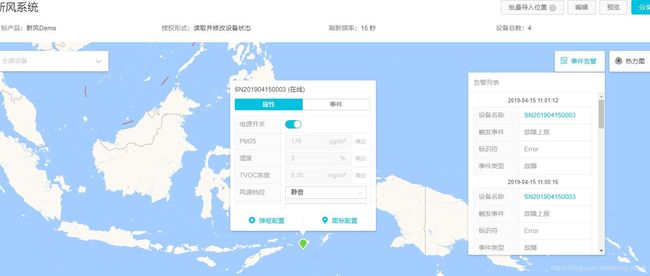基于阿里云物联网平台--使用Python模拟设备上报参数
基于阿里云物联网平台--使用Python模拟设备上报
- 一、前言
- 二、阿里物联网平台中定义产品
- 三、Python模拟设备上报
- A、启动配置
- B、初始化MQTT连接、配置物模型
- C. 一型一密下注册设备
- D、各类回调函数
- E、SDK回调函数连接
- F、模拟设备属性
- G、 通讯DEMO
- 四、上报结果
一、前言
最近阿里云物联网平台改版,刚好利用此机会再次了解下MQTT相关内容,本文使用Python语言模拟设备进行数据上报,下一篇文章将介绍使用Python进行云端控制该模拟设备.
二、阿里物联网平台中定义产品
本文默认您已经在物联网平台创建了产品

并在产品中定义了如下功能:

在设备中添加了一台设备:

三、Python模拟设备上报
A、启动配置
首先导入官方SK及相关需要使用的包
import configparser , time , hmac , hashlib , logging , os , sys , random
from linkkit import linkkit
进行基本的配置
LOG_FORMAT = "%(thread)d %(asctime)s %(levelname)s %(filename)s %(lineno)d %(message)s"
DATE_FORMAT = "%m/%d/%Y-%H:%M:%S-%p"
logging.basicConfig(format=LOG_FORMAT , datefmt=DATE_FORMAT)
# 读取相关配置:HostName 、ProductKey 、DeviceName 、DeviceSecret
conf = configparser.ConfigParser()
config_path = '../WIFI_GPRS_Config.cfg' # 配置文件路径
conf.read(config_path)
HostName = conf.get('SETTINGS' , 'hostname')
ProductKey = conf.get('SETTINGS' , 'productkey')
DeviceName = conf.get('SETTINGS' , 'devicename')
ProductSecret = conf.get('SETTINGS' , 'productsecret') # 一型一密
if conf.has_option('SETTINGS' , 'devicesecret'):
DeviceSecret = conf.get('SETTINGS' , 'devicesecret')
else:
DeviceSecret = ''
上述if else判断语句的目的:如果是一机一密,则直接获取配置文件的DeviceSecret ,否则DeviceSecret 置空,进行一型一密的设备注册获取设备密钥(具体见步骤C)
关于一机一密及一型一密,请见官方解释.。
B、初始化MQTT连接、配置物模型
lk = linkkit.LinkKit(
host_name=HostName ,
product_key=ProductKey ,
device_name=DeviceName ,
device_secret=DeviceSecret , # 一机一密 / 一型一密
# product_secret = ProductSecret #一型一密 若使用一型一密,增加此行
)
lk.enable_logger(level=logging.DEBUG)
lk.thing_setup('../Resources/WIFI_GPRS_Data.json') #物模型路径
注意:物模型需要使用完整物模型(在产品-功能定义-查看物模型-导出完整物模型)
C. 一型一密下注册设备
若使用一型一密,需要使用此方法(使用一机一密请跳过此步):
def on_device_dynamic_register(rc , value , userdata) :
if rc == 0 :
conf.set('SETTINGS' , 'DEVICESECRET' , value) #持久化device secret
with open(config_path , 'w') as configfile :
conf.write(configfile)
logging.info("dynamic register device success, rc:%d, value:%s,userdata:%s" % (rc , value , userdata))
else :
logging.warning("dynamic register device fail,rc:%d, value:%s" % (rc , value))
#首次启动判断,若无DEVICESECRET,则调用如上注册函数
if not conf.has_option('SETTINGS' , 'DEVICESECRET'):
lk.on_device_dynamic_register = on_device_dynamic_register
一型一密 , 首次需要持久化device secret,首次之再次启动模拟设备只能使用持久化的devicesecret,否则会无法连接;
另外一型一密需要提前开启产品的动态注册接口
D、各类回调函数
@连接
def on_connect(session_flag , rc , userdata) :
logging.info("on_connect:%d,rc:%d,userdata:" % (session_flag , rc))
@断开连接
def on_disconnect(rc , userdata) :
logging.info("on_disconnect:rc:%d,userdata:" % rc)
@Topic消息
def on_topic_message(topic , payload , qos , userdata) :
logging.info("on_topic_message:" + topic + " payload:" + str(payload) + " qos:" + str(qos))
@订阅
def on_subscribe_topic(mid , granted_qos , userdata) :
logging.info("on_subscribe_topic mid:%d, granted_qos:%s" %
(mid , str(','.join('%s' % it for it in granted_qos))))
@取消订阅
def on_unsubscribe_topic(mid , userdata) :
logging.info("on_unsubscribe_topic mid:%d" % mid)
@发布消息
def on_publish_topic(mid , userdata) :
logging.info("on_publish_topic mid:%d" % mid)
@上报属性
def on_thing_prop_post(request_id , code , data , message , userdata) :
logging.info("on_thing_prop_post request id:%s, code:%d message:%s, data:%s,userdata:%s" %
(request_id , code , message , data , userdata))
@云端设置属性
def on_thing_prop_changed(message , userdata) :
if "PowerSwitch" in message.keys() :
prop_data["PowerSwitch"] = message["PowerSwitch"]
elif "WindSpeed" in message.keys() :
prop_data["WindSpeed"] = message["WindSpeed"]
elif "WorkMode" in message.keys() :
prop_data["WorkMode"] = message["WorkMode"]
else :
logging.warning("wrong data:%s" % message)
lk.thing_post_property(message) # SDK不会主动上报属性变化,如需要修改后再次上报云端,需要调用thing_post_property()发送
print('prop_data:' , prop_data)
print('message:' , message)
logging.info("on_thing_prop_changed data:%s " % message)
== 注意SDK不会主动上报属性变化,如需要修改后再次上报云端,需要调用thing_post_property()发送==
@用户可以进行属性上报,事件上报,服务响应,此调用需要在连接前
def on_thing_enable(userdata) :
logging.info("on_thing_enable")
E、SDK回调函数连接
SDK进行回调连接
lk.on_connect = on_connect
lk.on_disconnect = on_disconnect
lk.on_thing_enable = on_thing_enable
lk.on_subscribe_topic = on_subscribe_topic
lk.on_unsubscribe_topic = on_unsubscribe_topic
lk.on_topic_message = on_topic_message
lk.on_publish_topic = on_publish_topic
lk.on_thing_call_service = on_thing_call_service
lk.on_thing_event_post = on_thing_event_post
lk.on_thing_prop_changed = on_thing_prop_changed
lk.on_thing_prop_post = on_thing_prop_post
lk.connect_async()
lk.start_worker_loop()
time.sleep(2) # 延时
在启动连接后增加2s的延时,否则会导致还没有连接成功就上报数据,然后报错
F、模拟设备属性
prop_data = {
"PowerSwitch" : 1 ,
"WindSpeed" : 1 ,
"WorkMode" : 1 ,
}
filter_data = {
'CartridgesLife' : 5000.1 ,
}
上述参数在功能定义中为:读写;故与属性上报(只读分开),便于云端设置模拟设备的参数使用
模拟循环上报100次数据(上报只读属性的参数):
counts = 100 # 模拟上报100次
while counts > 1 :
pdata = {
"MotorSpeed" : random.randint(8000 , 12000) ,
"PM25" : random.randint(1 , 255) ,
"CurrentPower" : round(random.uniform(2000 , 4000) , 2) ,
"CurretWindSpeed" : round(random.uniform(0 , 450) , 1) ,
"TVOC" : round(random.uniform(0 , 3) , 2) ,
"CurrentTemperature" : round(random.uniform(-20 , 55) , 2) ,
'Humidity' : random.randint(0 , 100) ,
'GeoLocation' : {
'Longitude' : round(random.uniform(-180 , 180) , 6) ,
'Latitude' : round(random.uniform(-90 , 90) , 6) ,
'Altitude' : random.randint(0 , 9999) ,
'CoordinateSystem' : random.randint(1 , 2) ,
}
}
rc , request_id = lk.thing_post_property({**prop_data , **pdata})
if rc == 0 :
logging.info("thing_post_property success:%r,mid:%r,\npost_data:%s" % (rc , request_id , prop_data))
else :
logging.warning("thing_post_property failed:%d" % rc)
events = ("Error" , {"ErrorCode" : random.randint(0 , 5)})
rc1 , request_id1 = lk.thing_trigger_event(events)
if rc1 == 0 :
logging.info("thing_trigger_event success:%r,mid:%r,\npost_data:%s" % (rc1 , request_id1 , events))
else :
logging.warning("thing_trigger_event failed:%d" % rc)
time.sleep(60)
counts -= 1
G、 通讯DEMO
为方便演示通讯及接收云端数据,将循环按步骤区分见下:
while True :
try :
print('''Please input operation code:
Code example:
'1':disconnect,
'2':connect,
'3':subcribe topic,
'4':unsubcribe topic,
'5':publish topic,
'6':thing_post
''')
msg = input()
except KeyboardInterrupt :
sys.exit()
else :
if msg == '1' :
lk.disconnect()
elif msg == '2' :
lk.connect_async()
elif msg == '3' :
rc , mid = lk.subscribe_topic(lk.to_full_topic("user/get"))
if rc == 0 :
logging.info("subcribe topic success:%r,mid:%r" % (rc , mid))
else :
logging.warning("subcribe topic failed:%d" % rc)
elif msg == '4' :
rc , mid = lk.unsubscribe_topic(lk.to_full_topic("user/get"))
if rc == 0 :
logging.info("unsubcribe topic success:%r,mid:%r" % (rc , mid))
else :
logging.warning("unsubcribe topic failed:%d" % rc)
elif msg == '5' :
rc , mid = lk.publish_topic(lk.to_full_topic("user/update") , '"WorkingStatus":3')
if rc == 0 :
logging.info("publish topic success:%r,mid:%r" % (rc , mid))
else :
logging.warning("publish topic failed:%d" % rc)
elif msg == '6' :
# 此处内容见步骤E
pass
# 此处内容见步骤E
else :
logging.warning("Error Code!!!!!!!!!!!!! ")
continue
第六步循环上报属性见步骤E
四、上报结果

空间数据可视化:

结语:
本文只是简单介绍设备的模拟使用;
下一篇文章介绍使用Python云端控制模拟设备进行参数设置
参考
[1]: https://help.aliyun.com/document_detail/42648.html?spm=a2c4g.11174283.6.641.3a8b1668A6pEm6
[2]: https://help.aliyun.com/document_detail/108675.html?spm=a2c4g.11174283.6.556.2d835523OO5lpo
